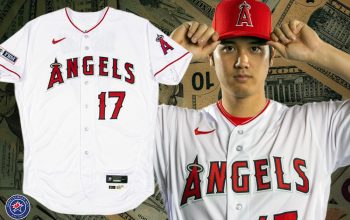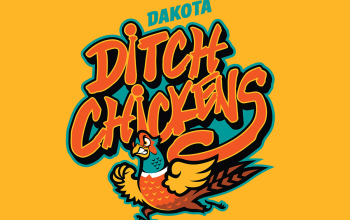Along the coast of southern Alabama lies an inlet of the Gulf of Mexico called the Mobile Bay. In the city of Mobile, you’ll find the double-A Southern League affiliate of the Arizona Diamondbacks, the Mobile BayBears. In case these two facts lead to incorrect assumptions, here’s this very important fact from Justin Baker, the team’s director of broadcasting and media relations: “There is no bear that lives in the bay.”

The team’s name does not come from some sort of aquatic ursinis, but rather a combination of the city’s baseball history (specifically, a team that played from 1918 to 1930 and 1944 to 1961) and its geographic location.
“One of Mobile’s original baseball teams was the Mobile Bears,” Baker said. “So in ’97, when they first started here in Mobile, they wanted to pay homage to them somehow, but kind of add a new flair—not just automatically go back to the old name.”
He continued, “BayBears was strictly a play on the Mobile Bay and Bears is a part of the original name given to the Mobile team.”
 The BayBears (one word, two capital Bs) have existed in their current location since 1997, but the team underwent a major rebranding effort in 2010, the overall effect of which was to go from cuddly to menacing.
The BayBears (one word, two capital Bs) have existed in their current location since 1997, but the team underwent a major rebranding effort in 2010, the overall effect of which was to go from cuddly to menacing.
“They did intentionally want to go to a more ferocious bear,” Baker said. “A lot of teams are going back to the cartoonish logo, and then with us, where we started with a cartoon logo, we wanted to go back with something a little more fierce.”
The team’s first color scheme had a decidedly local flavor. “The original logo was to play on the color scheme of both the University of Alabama and the University of Auburn,” Baker said. “And that’s where you got the blue, the crimson, and the white from.”
The 2010 rebranding effort brought a new color scheme with a much broader focus, including two kind of obvious colors and one whose meaning is just as significant, but maybe not immediately evident. “There’s two different blue schemes,” Baker said. “What that’s supposed to represent is the color of the Mobile Bay—the water, if you will—the light blue and the dark blue, depending on the day.”
The less obvious color choice also comes from the local geography. “A lot of people think that the BayBears uniforms are white, and they’re not. That off white is actually a sand color,” Baker said. “So you’re going with a true coastal feel, like the beach. All of that was intentional.”
The reason for the color change, and the rebranding effort in general, was to acknowledge their status as one of the elder statesmen of the league. “Instead of it just appealing to the state,” Baker said, “now after 13 years at the time they changed the logo, they wanted to say okay we’ve established ourselves in Mobile, so we need to establish ourselves outside of Alabama and Auburn fan bases.”
Another reference to the bay can be found on one of the team’s cap logos, which the team refers to internally as the M wave. The form itself has a decidedly watery feeling. “The reason that is there is that the M is in a wave format to symbolize the waves in the Mobile Bay,” Baker said.
Just as the team’s name balances the city’s history and its location, so does its visual identity. Another letter M in their logo set refers back to the team’s heritage. “If George Washington was writing to Thomas Jefferson, he would have used that font,” Baker said. “The design of that one was paying homage to the original Mobile Bears. It’s like the old Atlanta Braves hats with the lower-case A, it’s one of those things that’s still just as hot as the new stuff.”
The team’s more recent history came into play when they redesigned their uniforms. With simple cursive lettering across the chest, the uniforms evoke another Major League team, one that was their parent club from the inception of the BayBears until 2006.
 “It was supposed to look like the Jake Peavy Padres,” Baker said. “Jake Peavy was the biggest name in the BayBears at the time because he is a Mobile native. Growing up, he had played in the BayBears High School Baseball Classic, and he made it to the Majors having gone through Mobile. That was kind of the whole thing, they wanted to ride the wave to success with Jake and that was why they went with the Padres-schemed uniforms back then.”
“It was supposed to look like the Jake Peavy Padres,” Baker said. “Jake Peavy was the biggest name in the BayBears at the time because he is a Mobile native. Growing up, he had played in the BayBears High School Baseball Classic, and he made it to the Majors having gone through Mobile. That was kind of the whole thing, they wanted to ride the wave to success with Jake and that was why they went with the Padres-schemed uniforms back then.”
Pictured at right is top Diamondbacks pitching prospect Archie Bradley, who played parts of 2013 and 2014 in Mobile and will likely start 2015 in triple-A Reno. Jake Peavy, a BayBear in the early 2000s, is pictured above wearing the Padres uniform in question.
 The BayBears new primary logo (referred to by some staff members in Mobile as the dirty bear because of what it looks like it’s doing to that baseball) was designed by Brandiose. And because Brandiose was involved, one of their new alternate logos features a character swinging a bat.
The BayBears new primary logo (referred to by some staff members in Mobile as the dirty bear because of what it looks like it’s doing to that baseball) was designed by Brandiose. And because Brandiose was involved, one of their new alternate logos features a character swinging a bat.
As with most swinging mascot logos, you have to raise the question of baseball fundamentals. “If you were to ask our hitting coach the last two years, Jacob Cruz,” Baker said, “he would definitely tell you that he obviously does not have an open stance. It’s a very closed stance.”
And that concern carries all the way up to the Majors. “Turner Ward, who is the hitting coach for the Arizona Diamondbacks, is a Mobile native, and was the manager here in ’11 and ’12,” Baker said. “He did make a couple of jokes about the bear itself. The only thing he’s going to do there is foul off a couple of pitches with that stance.”
While the team’s identity is decidedly bear-centric, their one attempt to host a live bear at the stadium in 2013 conjured images of a scene in the Will Ferrell movie Semi-Pro, the events of which led frantic minor league basketball team owner Jackie Moon to scream, “Everybody panic! Oh my God, there’s a bear loose in the coliseum! There will be no refunds! Your refund will be escaping this deathtrap with your life!”
Upon considering the pluses and minuses of having a live bear at the stadium, Baker said, “We had this fear of having him at the ballpark and it turning into the movie where he gets out and everybody freaks out. So they did away with that.”
It’s not immediately evident just how much thought there is behind the name BayBears. At first glance, the nickname looks like it might be one of those minor league entities that took a nearby geographic feature and a mascot-ish animal, removed the space between the words, and called it a team name. But the BayBears’ efforts to honor their city’s baseball heritage while staking a claim to their own identity give the name extra significance, and make it one of the stories worth telling.
















